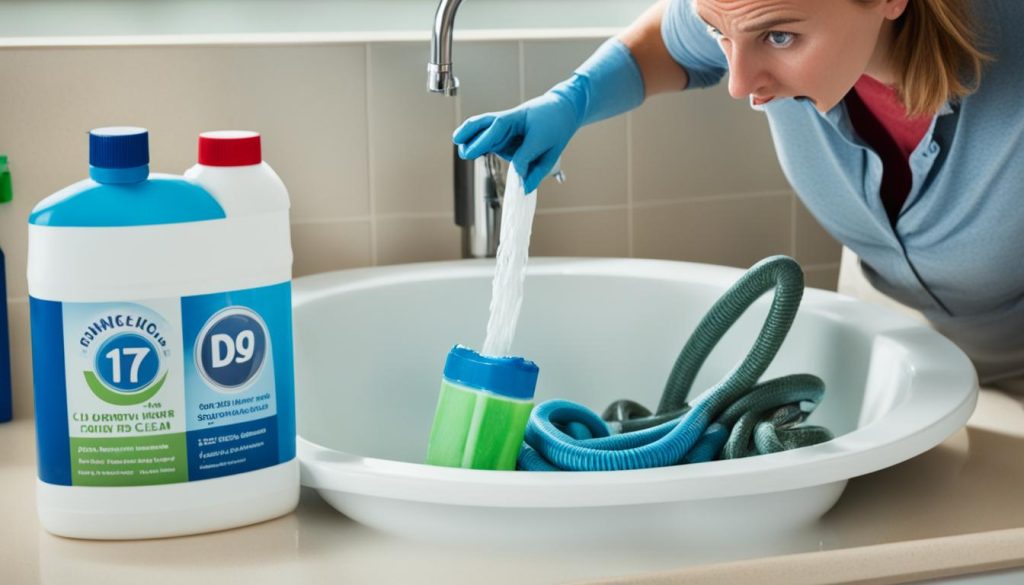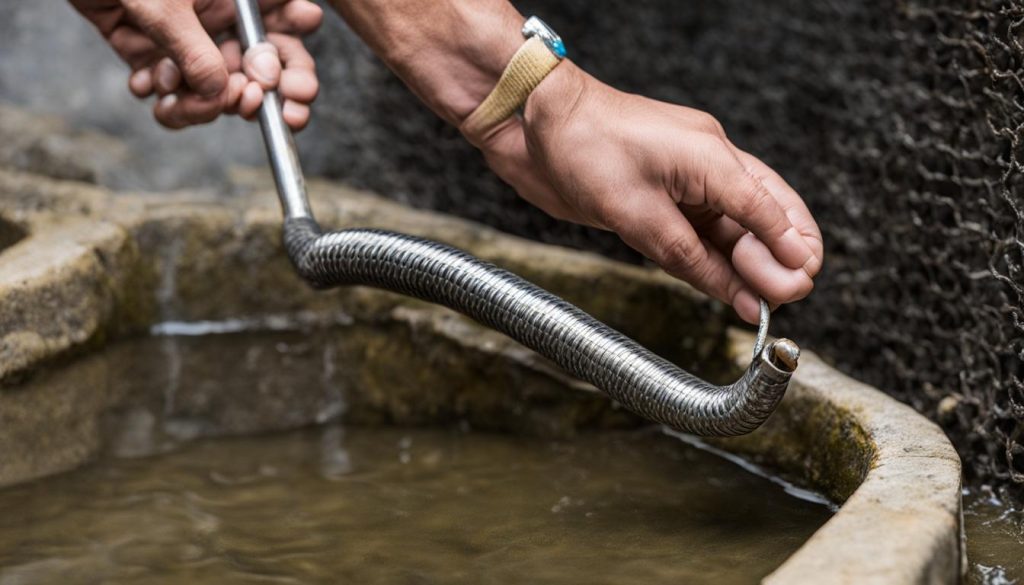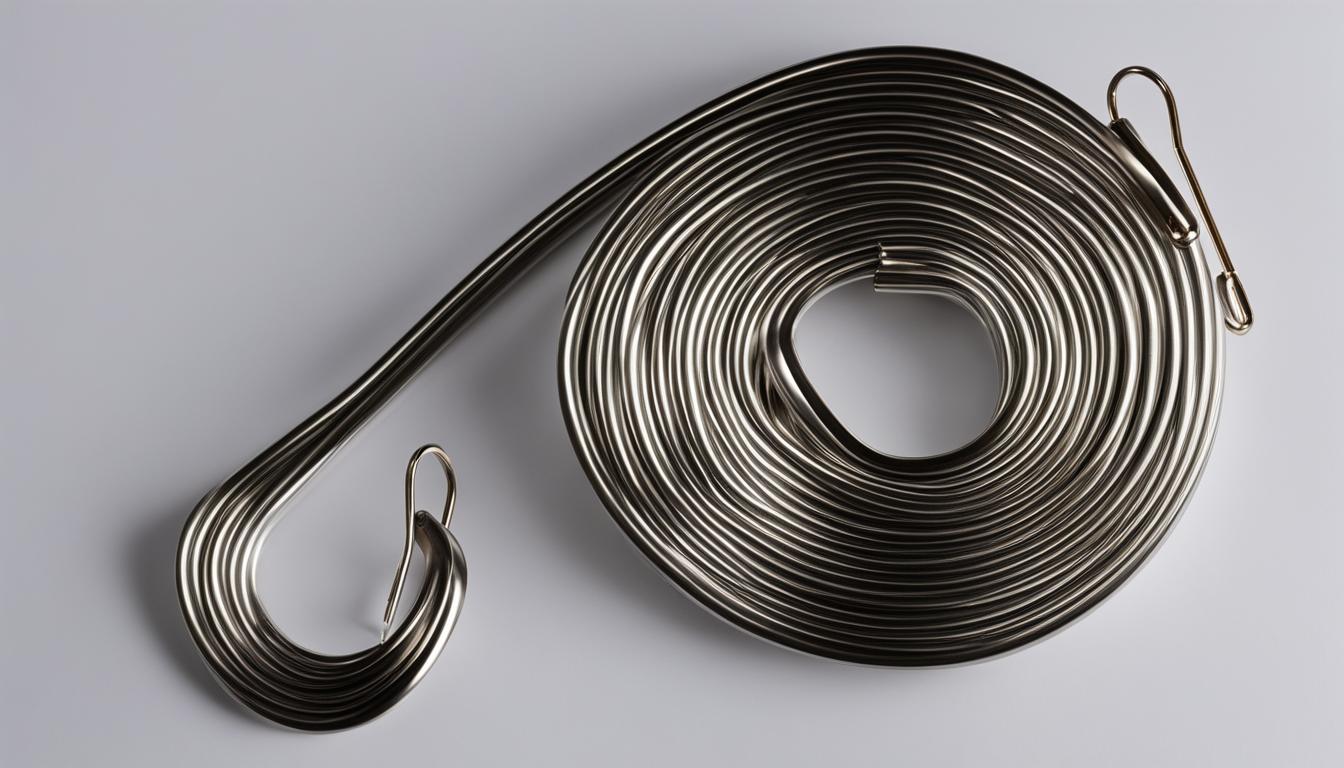Did you know that clogged drains account for approximately 20% of all plumbing-related calls in Canada? That’s right! A staggering number of homeowners and businesses face the inconvenience and frustration of blocked sinks, bathtubs, and showers. Thankfully, there’s a simple and effective solution to this common problem: the drain snake.
Key Takeaways:
- A drain snake is a tool used to clear clogs in drains.
- It consists of a long, flexible coiled wire with a corkscrew end.
- By inserting the wire into the drain and turning the crank, the drain snake breaks down or removes the blockage.
- Drain snakes are highly effective for unclogging sinks, bathtubs, and showers.
- They are not recommended for use in toilets, which require a different tool called a closet auger.
Types of Drain Snakes
When it comes to unclogging drains, there are various types of drain snakes available that cater to different needs and situations. Understanding these different types can help you choose the right tool for the job.
The handheld drain snake is the most common type of drain snake used for clearing most clogs. It is compact, easy to use, and affordable, making it a popular choice for household use. This type of snake is typically suitable for clearing clogs up to 20 feet down the pipe.
2. Closet Auger:
The closet auger is specifically designed for unclogging toilets. It features a protective rubber coating over the coiled wire to prevent any damage to the porcelain. The unique design allows it to navigate the curves and bends of the toilet drain, effectively removing stubborn clogs.
3. Heavy-Duty Drain Snake:
In cases where you’re dealing with stubborn blockages that require more power, a heavy-duty drain snake is the ideal choice. These drain snakes are more robust and may come with attachments that allow them to be operated with a drill or motor. They offer the extra strength needed to break through tough clogs.
Regardless of the type of drain snake you choose, they are primarily used for clearing clogs caused by hair, food debris, cooking grease, soap scum, and even objects that have been flushed down the drain.
Benefits of Using a Drain Snake
Using a drain snake offers several benefits compared to other methods of clearing clogs. Let’s explore why a drain snake is a preferred choice for dealing with stubborn blockages.
1. Eco-Friendly Solution
A drain snake is a more environmentally friendly option compared to chemical drain cleaners. Chemical cleaners can be harsh and harmful to both your pipes and the environment. By using a drain snake, you can avoid introducing harmful chemicals into your drainage system and reduce your ecological footprint.
2. Manual Control
A drain snake provides you with manual control over the unclogging process. Unlike relying on chemical reactions, you can physically maneuver the drain snake to break up and remove the clog. This hands-on approach allows you to have more control and ensures a more efficient unclogging process.
3. Effective Clog Removal
Drain snakes are highly effective at breaking up and removing clogs. The flexible coiled wire can navigate through the twists and turns of the drainpipe, reaching deep into the pipe to tackle tough blockages. Whether it’s hair, food debris, cooking grease, soap scum, or even small objects, a drain snake can handle them all.
4. Versatility
A drain snake is a versatile tool that can be used for various types of drains, including sinks, bathtubs, and showers. Its flexible design allows it to adapt to different pipe sizes and configurations. With a drain snake at your disposal, you can tackle clogs in multiple areas of your home using a single tool.
5. Drain Snake vs Plunger
When comparing a drain snake to a plunger, the drain snake offers several advantages. While a plunger is effective at clearing simple clogs near the drain opening, it may struggle with deeper blockages. A drain snake, on the other hand, has the ability to reach further into the pipe, making it ideal for dealing with more stubborn clogs.
| Benefits of Using a Drain Snake | Benefits of Using a Plunger |
|---|---|
| Effective for tough blockages | Effective for simple clogs |
| Versatile: Suitable for various types of drains | Primarily used for sinks and toilets |
| Provides manual control over the process | Relies on pressure for unclogging |
| Environmentally friendly | May require the use of chemical cleaners |
When to Use a Drain Snake
A drain snake is an effective tool to use when other methods, such as plunging or home remedies, have failed to clear a stubborn clog. If you’re experiencing slow or inadequate drainage in your sinks, bathtubs, or showers, it’s a strong indication that a drain snake might be necessary. Clogs caused by hair, food debris, cooking grease, soap scum, or small objects can be effectively removed with a drain snake.
However, it’s important to note that a drain snake is not suitable for use in toilets. For toilet clogs, a specific tool called a closet auger should be used instead.
Signs that indicate the need for a drain snake:
- Water is not draining properly
- Water is backing up in sinks, bathtubs, or showers
Using a drain snake can save you time and effort by quickly and efficiently clearing clogs. It provides a manual, mechanical solution that gives you more control over the unclogging process. By using a drain snake, you can avoid the use of harsh chemical drain cleaners, which can be detrimental to both your pipes and the environment.
Next, let’s explore how to properly use a drain snake to effectively clear clogs.

| WHEN TO USE A DRAIN SNAKE |
|---|
| Water is not draining properly |
| Water is backing up in sinks, bathtubs, or showers |
| Clogs caused by hair, food debris, cooking grease, soap scum, or small objects |
How to Use a Drain Snake
Using a drain snake is a relatively simple process. To effectively clear a clog using a drain snake, follow these steps:
- 1. Wear protective gear: Before starting, it is essential to ensure your safety. Wear rubber gloves and safety goggles to protect your hands and eyes from any potential hazards.
- 2. Insert the drain snake: Take the drain snake and insert the corkscrew end into the drain opening. Make sure it goes in smoothly and reaches the clog.
- 3. Slowly turn the crank: Once the drain snake is inserted, begin turning the crank slowly. This action will feed the wire further into the drain, allowing it to reach the clog.
- 4. Apply pressure: While turning the crank, apply gentle pressure to break up the clog or grab onto the object causing the blockage. Keep a steady pace to ensure effective unclogging.
- 5. Retract and repeat if necessary: If the drain snake encounters resistance or hasn’t completely cleared the clog, retract it partially or fully. Repeat the process of insertion, turning the crank, and applying pressure until the drain is clear and water can flow freely again.
It is important to note that while using a drain snake, you should avoid using chemical drain cleaners simultaneously. The combination of the two can result in hazardous reactions and cause harm. Stick to using the drain snake as a standalone solution for clearing clogs. As always, prioritize safety and follow the manufacturer’s instructions for your specific drain snake model.

| Steps | Description |
|---|---|
| 1 | Wear protective gear |
| 2 | Insert the drain snake |
| 3 | Slowly turn the crank |
| 4 | Apply pressure |
| 5 | Retract and repeat if necessary |
When to Seek Professional Help
While a drain snake is a useful tool, there are certain situations where it is best to seek professional help. If you are dealing with clogs caused by tree roots in side sewer pipes, old and fragile pipes that are prone to breakage, recent use of chemical drain cleaners, or repeated unsuccessful attempts to remove the blockage, it is advisable to call a professional plumber.
They have the expertise and specialized equipment to handle more complex clogs and ensure that the drain is properly cleared without causing further damage. Additionally, if you do not feel comfortable attempting to clear the drain yourself, it is always better to leave it to the professionals.
